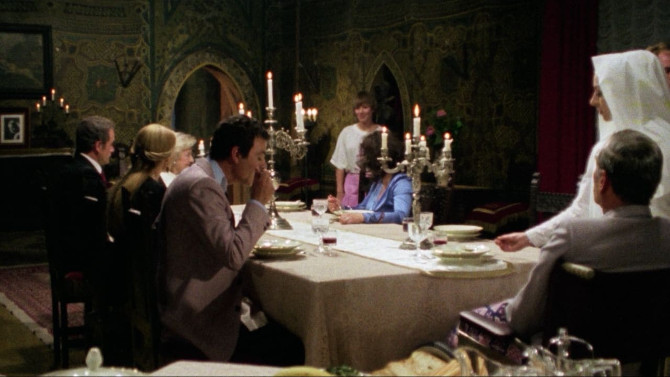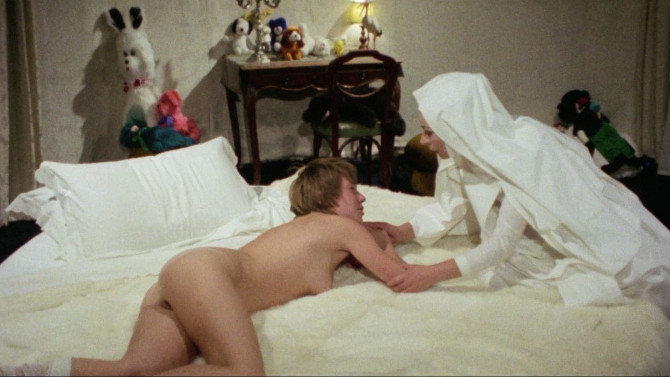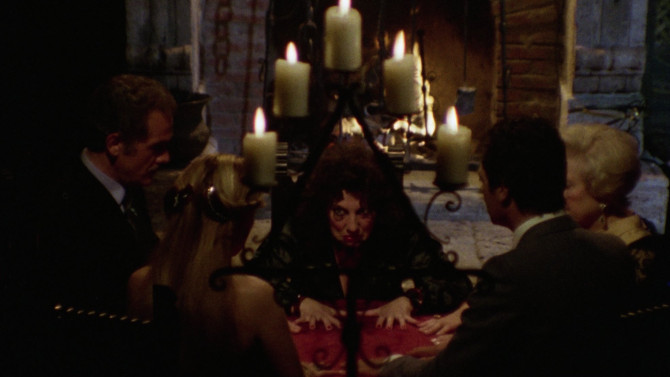‘What Could Have Been’ is a continuing look into the reels of film history, analysing movies that could have been something special, but due to problems with script, production, budgetary, or any other type of issue, did not reach its full potential.
Like The Exorcist hopped up on a lethal combination of steroids and Viagra, 1979’s Malabimba, directed by envelope pushing Andrea Bianchi (for a reminder of his more well known work, think of his playfully edgy 1975 giallo Strip Nude for Your Killer), is an Italian motion picture not for the faint of heart. . . or you, like one of the characters in the film, might find yourself stone cold.
Of course, reading this, I’m sure most will think that this is some sort of poorly done, sleazy exploitation piece attempting to capitalize on the aforementioned horror classic. And though the second sentiment is wholly true, the former is most definitely not so.
Though Malabimba was shot in just under two short weeks, everything about the project oozes quality. Filmed in a most picturesque, gothic-style historic castle (Piccolomini in Balsorano – the setting of a large number of other productions around this time, including 1970’s The Lickerish Quartet, 1971’s Lady Frankenstein. . .), it is a stunning, dilapidated, secluded structure sitting atop a hill and surrounded by a lush forest.
Within lives a family that might just make the Usher’s (from the classic Edgar Allan Poe short story) look pretty functional. Led by patriarch Andrea Caroli (Enzo Fisichella), he is still mourning the death of his beloved wife (meaning that, at least for awhile, he will show self restraint). He is also struggling to afford the castle that his family has inhabited for fifteen generations.
Aimed at cheering him up, the rest of his family, including his mother (Pupita Lea Scuderoni), his invalid brother Adolfo (Giuseppe Marrocco), Adolfo’s ‘family-recognized’ slut of a wife, Nais (Patrizia Webley), and Giorgio (Giancarlo Del Duca) – an interloper (he may be their lawyer) who never seems to want to leave, have hired a Medium (Elisa Mainardi) to try to communicate with his deceased wife (who wouldn’t?). . . instead, she makes contact with the long shamed (and long dead) black sheep of the family, Lucrezia, who, whilst festering over the generations, has grown vengeful in regards to her successor’s hypocrisy.
At first having a little bit of fun with the seance, the spirit heads out, looking for a host to grab onto. Attempting to enter the resident nun in training, Suor Sofia (Mariangela Giordano), her spirit is too strong, so instead, she infiltrates the soul of Andrea’s innocent, long sheltered daughter, Bimba (Katell Laennec) – you know that with a name like that, she is doomed.
Bianchi, a talented director, utilizes a number of techniques to achieve his goal. From first person spirit perspective and cheeky visual gags, to sensual voyeurism, his castle-chosen setting is symbolic of the cracking, mouldy decay of the family itself. Paired with absolutely striking cinematography from Franco Villa (the scene where Sofia is first attacked by the spirit, a revelation – her use of her hands to form a cross, projected by light onto the wall, a thing of beauty), this historic structure has never looked more disturbingly erotic (plus, a secret passageway never hurts).

A perfect backdrop for this sordid family, these characters are surprisingly engaging. Laennec’s Bimba (her first and only role), the centre of the piece, looks at utter ease in front of the camera. A balancing act between overly innocent ingénue and possessed harbinger of smutty evil, her room, filled with bizarre toys and stuffed animals, might just be the most disturbing part of this entire film. In many ways her foil, Giordano’s Sofia is the most well rounded and dynamic character. In other hands likely more one dimensional, she adds such grace to her role. . . her spirit and faithful belief the heart of the movie. The men, on the other hand, are there for other reasons. Andrea, more distracted than anything, barely seems to notice that anything is wrong with his daughter (more flummoxed at his mother’s insistence that he marry his brother’s wife to save the family fortune), his brother, a wheel-chair bound mute will soon be in for one helluva night, while mysterious Giorgio, in that – ‘why is he still here?’, is happy to be devouring some chicken. . . even while being insulted during a rather unusual family dinner. Lastly, Wembley’s Nais is the most fascinating character. The aforementioned slut, unlike in other films, owns her sexuality, free-wheeling and powerful. . . making her way through the men in short order (and supporting her niece’s sexual awakening – while all of the other secretly depraved castle dwellers look on in shock). Warning: a slight spoiler here – she does not get her comeuppance for this (which, in a weird way, is a very forward thinking perspective for a film such as this). Another noteworthy comment – nearly everyone in the family seems to have a nice collection of evening-wear robes. . . Hugh Hefner would approve.

So, you must be wondering, after all of this praise, where did this film go wrong? After its kitschy and wonderfully shaped opening scenes, it actually gets bogged down a little bit with all of the sex (I know, shocking). Also, many films from this era were forced, in post production, to add in a few hardcore moments (so that they could play in the growing adult cinemas of the time – probably accounting for about forty-five seconds of the film). Never very well done, it is jarring – firstly, because it is not part of the original piece; secondly, because it isn’t the real actors. . . it is always unsettling to get a quick glimpse of a male ass and balls from behind (a lame way of hiding that it is not the real actors). . . talk about a horror show. Though this was par for the course at the time (especially in Europe), it takes away from the final project. With some editing touches here and there (trimming down the sex scenes), and a few more sequences amongst the characters (to build the horror aspects a bit more), this really could have been a more tightly wrapped exploitation package.
An outré piece of exploitation cinema, if you’re caught watching Malabimba, you might just catch yourself shouting out ‘THE DEVIL MADE ME DO IT!!!’, much like the characters should be in the film. A visual kaleidoscope of shadow and light, dilapidated castles and snake-filled gardens, gothic horror mixed with sensual sexuality, as well as plenty of T&A, if you’re into bonkers retro cinema, this one will definitely be for you. So, beware of sultry spirits, unless they’re the tasty alcoholic kind (in fact, that may help), and take a leap of faith into this secluded world that has not been experienced by very many.
This film is in Italian with English subtitles

